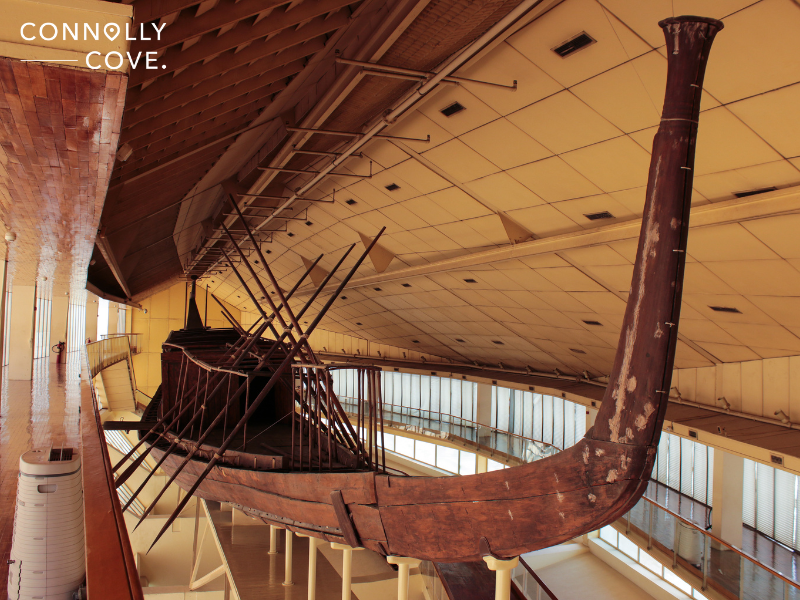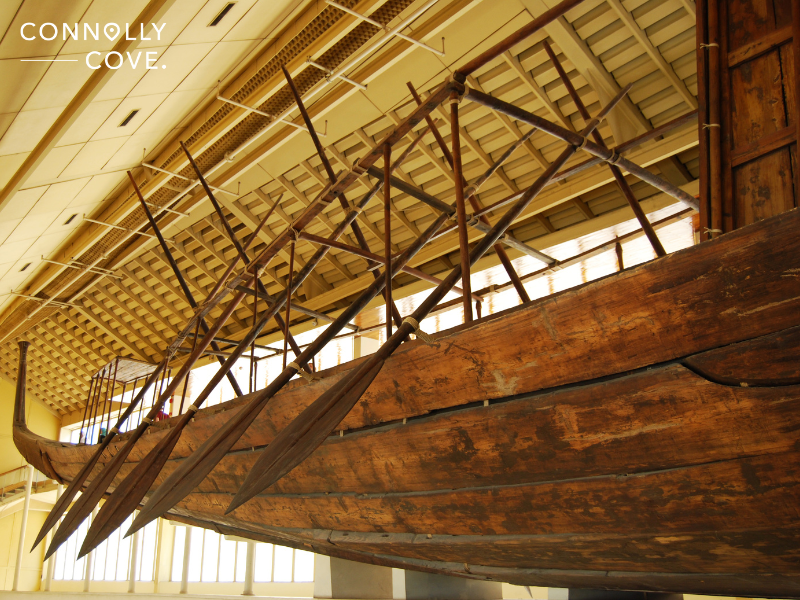A Voyage From the Solar Boat Museum to the Grand Egyptian Museum

Updated On: April 04, 2024 by Raghda Elsabbagh
It was 1954, on the sun-drenched landscapes of Giza, and a team of archaeologists were digging near the Great Pyramid of Giza. It was in this moment of excavation that the Solar Boat emerged from its slumber, patiently awaiting the gaze of our modern world. Unearthing the Solar Boat, also known as the Khufu Ship, was a stroke of luck. Still, its discovery was a significant milestone in Egyptology, as it provided a rare glimpse into the ancient Egyptians’ ceremonial practices.
The Solar Boat Museum was built in the heart of Cairo, Egypt, around 1985 to house this 4,500-year-old boat. Yes, a whole museum was created just for it! The ship was, and still is, considered one of the most remarkable archaeological finds of all time. Let’s delve deeper into the historical background of the Solar Boat and learn more about this fascinating piece of history.

Table of Contents
The Discovery of the Solar Boat
The discovery and excavation of the Solar Boat was a remarkable feat, and it has provided invaluable insights into the ancient Egyptians‘ engineering and religious beliefs.
The story of the Solar Boat dates back to 1954 when the renowned Egyptian archaeologist Kamal el-Mallakh stumbled upon a pit near the Great Pyramid of Giza. The pit was found to contain the disassembled pieces of a boat, which was later reconstructed by a team of experts.
The boat was found to be in an excellent state of preservation, and it was believed to be the funerary boat of King Khufu. The discovery of this boat unravelled a mystery that had been shrouded in the sands of time for over 4,500 years and shed light on the advanced boat-building techniques of the ancient Egyptians.
Challenges Faced During Excavation and Restoration
The excavation of the Solar Boat was challenging, as the boat was buried deep beneath the sand and rubble. Unearthing a vessel entombed for over 4,500 years required delicate precision and unwavering patience.
The excavation team had to use various techniques, such as dredging and sifting, to uncover the boat’s remains, piece by piece, without compromising its structural integrity. The boat’s fragments were transported to a nearby warehouse, where they were carefully analysed and reconstructed by chief restorer Ahmed Youssef Moustafa and a team of experts.
The restoration process was a delicate and time-consuming task, as the boat’s intricate design required significant attention to detail. The boat’s dismantled state took over a decade to restore to its former glory, and it was fully assembled in 1968. The restoration team employed a combination of traditional and modern techniques, such as the use of laser scanning and three-dimensional modelling, to ensure that the ship was restored to its original condition.
Purpose of the Solar Boat in Ancient Egypt
As the layers of sand and history were peeled away, the archaeological context of the Solar Boat came to light, revealing a treasure trove of insights into ancient Egyptian culture and technological and artistic achievements. Dating back to the reign of Pharaoh Khufu, the boat was meticulously crafted with cedarwood and intricate details, with each plank carefully joined to the next, reflecting the advanced craftsmanship of its time.
Ritualistic Use of the Solar Boat
The boat was believed to be used to transport the deceased pharaoh’s soul across the sky during their journey to the afterlife. Since it was discovered in a disassembled state, it was meant to be reassembled in the afterlife, giving us an insight into the ancient Egyptians’ beliefs about the afterlife and their ritual practices. The boat was also believed to symbolise the sun god Ra, who was thought to travel across the sky in a solar boat. The boat’s elaborate design suggests that it was also used for ceremonial and religious rituals, such as the Opet Festival, where the ship was carried on the shoulders of priests in a grand procession.
Symbolic Significance in Ancient Egyptian Beliefs
The boat’s intricate carvings and paintings depict various religious and mythical scenes, such as the pharaoh’s journey through the underworld. The boat was adorned with gold leaf and precious stones, adding to its grandeur and symbolic significance. Its sleek crescent shape, echoing the celestial cycle of the moon, symbolised rebirth and the cyclical nature of life.
The Solar Boat’s Construction and Design
The Solar Boat is an impressive sight, and its design and construction are a testament to the ancient Egyptians’ engineering prowess. It’s a grand vessel, measuring over 44 metres in length and 5.9 metres in width and featuring intricate carvings and paintings depicting various religious and mythical scenes.
The ancient Egyptians demonstrated remarkable craftsmanship, marking each piece of wood with precise locations in Hieroglyphics. The boat’s 1224 wooden pieces were strategically arranged in 14 layers, with a bottom layer of rocks preventing humidity damage for over 24 centuries. The boat boasts twelve paddles and a protective compartment at the stern for the captain.
The twelve paddles, five on each side, had unique bayonet shapes, possibly protecting the journey to the afterlife. Additionally, two paddles functioned like a rudder to correct the boat’s course. An ingenious depth-checking tool, shaped like the Lotus and Papyrus plants, guided the boat and prevented collisions with sand islands or shores.
Materials Used in Construction
The construction of the Solar Boat required skilled craftsmen who used various materials to assemble the vessel. The boat’s hull was made of cedar wood, which was imported from Lebanon, while the oars, paddles, and masts were constructed from acacia wood. The boat was also adorned with gold leaf and precious stones, adding to its grandeur.
The planks, meticulously fitted together with astonishing precision, showcase the mastery of ancient Egyptian boat-builders, ensuring the vessel’s seaworthiness in both earthly and divine realms. The construction of the Solar Boat required a significant amount of resources and manpower, a testament to the ancient Egyptians’ dedication to their religious beliefs.
Technological Advancements of Ancient Egyptian Boat-Building
The Solar Boat is a remarkable example of the ancient Egyptians’ technological advancements in boat-building. The boat’s design features a unique keel that allows it to navigate the Nile’s waters easily. The boat’s hull was constructed using a technique known as “mortise and tenon,” which involved carving out holes in the planks and fitting them together with wooden pegs. The Solar Boat’s hull was also coated with a resin layer, protecting it from water damage and making it more buoyant.
The Solar Boat Museum
Following the discovery of the Solar Boat, a museum was established above the excavation site, designed to accommodate the boat’s substantial size and equipped with state-of-the-art technologies for long-term preservation. The museum, spanning three floors, offered visitors the unique experience of viewing the solar boat from different perspectives. Placed on a raised base on the first floor, the boat occupied the central hall, while the ground floor allowed guests to observe the boat’s underside.
Preservation Methods Employed in the Solar Boat Museum

Since the Solar Boat is a delicate and priceless piece of history, preservation methods are employed in the Solar Boat Museum to ensure that the boat remains in excellent condition for future generations.
The boat’s wooden structure is susceptible to damage from environmental factors such as fluctuations in humidity and temperature. So, a comprehensive air conditioning system was integrated to maintain optimal humidity and temperature levels, that are essential in preventing the boat’s deterioration. Specialised lighting casts a gentle glow, illuminating the boat’s features without compromising its structural integrity.
The boat’s intricate carvings and paintings also require special care to prevent fading and deterioration. The museum, therefore, employs a team of experts who conduct regular inspections and maintenance checks to ensure that the boat remains in excellent condition.
Cultural Impact of the Solar Boat on Tourism
The museum attracts tourists from all over the world, boosting the local economy. The museum also provides educational opportunities about ancient Egyptian culture and history. Visitors can see the Solar Boat up close and learn about its ritualistic use and symbolic significance. The museum’s guided tours and educational programs are open to local schools and universities, providing a unique opportunity for students to learn about their cultural heritage.
Where is the Solar Boat Now?
It’s important to note that the Solar Boat Museum was disassembled in August 2021 after the boat was relocated to the Grand Egyptian Museum.
In conclusion, the Solar Boat is a fascinating artefact to glimpse the ancient Egyptians’ culture and beliefs. The discovery of the Solar Boat has shed light on the advanced boat-building techniques of ancient Egyptians and their beliefs about the afterlife. Visiting the Grand Egyptian Museum is a superb way to learn more about ancient Egypt and its rich cultural heritage.






